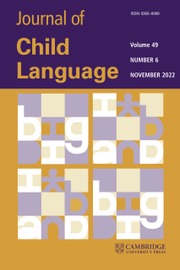Article contents
Role of adult input in young children's category evolution: II an experimental study*
Published online by Cambridge University Press: 17 February 2009
Abstract
Young children's initial categories often are not identical to the adult category labelled by the same word. Eventually, children's categories must evolve to correspond to the adult standard. The purpose of this study was to consider the relative effectiveness of four input strategies in inducing the child to learn the adult-appropriate label and begin to form a new category. Fifty-six children aged 2;0 were taught new labels for objects that they included in categories labelled by different names. Comprehension and production post-tests were then administered. As expected, the most effective strategy involved labelling an object and providing both a physical demonstration and a verbal description of important attributes that made the object a member of the adult-appropriate category. The label plus physical demonstration strategy was next most effective. Neither the label plus verbal description strategy nor the label only strategy was effective for children of this age. Results also indicated that these 24 month olds did not yet honour the convention of mutual exclusivity of basic level categories.
- Type
- Articles
- Information
- Copyright
- Copyright © Cambridge University Press 1988
Footnotes
This paper is based on a doctoral dissertation submitted by the first author to the University of Massachusetts, Amherst. Portions of this paper were presented at the November 1986 convention of the American Speech—Language—Hearing Association, Detroit, Michigan. We would like to thank the parents and children who participated in this study. Albyn Davis, Cindy Mervis, and Harry Seymour provided valuable comments on previous drafts of this paper. This research was supported by the National Science Foundation, grant no. BNS 84–19036.
References
REFERENCES
- 29
- Cited by


